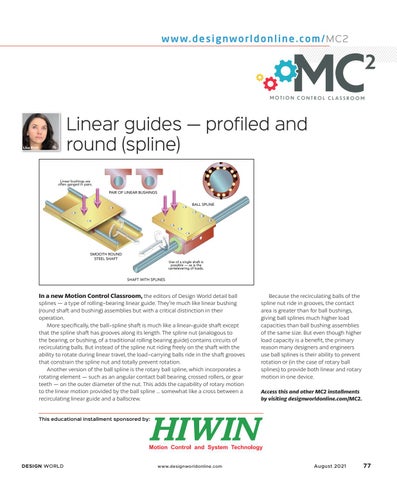w w w. d e s i g nw o r l d o n l i n e . c o m / M C 2
Linear guides — profiled and round (spline)
Lisa Eitel
In a new Motion Control Classroom, the editors of Design World detail ball splines — a type of rolling-bearing linear guide. They’re much like linear bushing (round sha and bushing) assemblies but with a critical distinction in their operation. More specifically, the ball-spline sha is much like a linear-guide sha except that the spline sha has grooves along its length. The spline nut (analogous to the bearing, or bushing, of a traditional rolling bearing guide) contains circuits of recirculating balls. But instead of the spline nut riding eely on the sha with the ability to rotate during linear travel, the load-carrying balls ride in the sha grooves that constrain the spline nut and totally prevent rotation. Another version of the ball spline is the rotary ball spline, which incorporates a rotating element — such as an angular contact ball bearing, crossed rollers, or gear teeth — on the outer diameter of the nut. This adds the capability of rotary motion to the linear motion provided by the ball spline … somewhat like a cross between a recirculating linear guide and a ballscrew.
Because the recirculating balls of the spline nut ride in grooves, the contact area is greater than for ball bushings, giving ball splines much higher load capacities than ball bushing assemblies of the same size. But even though higher load capacity is a benefit, the primary reason many designers and engineers use ball splines is their ability to prevent rotation or (in the case of rotary ball splines) to provide both linear and rotary motion in one device. Access this and other MC2 installments by visiting designworldonline.com/MC2.
This educational installment sponsored by:
DESIGN WORLD
MC Classroom_8-21_HIWIN_Vs2.indd 77
www.designworldonline.com
August 2021
77
7/30/21 2:31 PM








